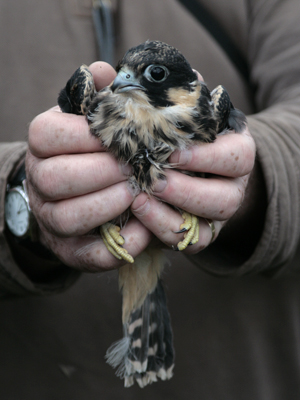
Scottish Raptor Study Group
Monitoring and conserving Scotland's birds of prey
Hobby

The Hobby arrives in the UK from late April onwards and leaves again in September and October. While sometimes observed on passage, the Hobby is best considered a very scarce summer visitor to Scotland with a breeding range restricted to a handful of sites. Long-winged, and with their black ‘moustache’ and smart red ‘trousers’, this distinctive bird is incredibly agile and specialises in hunting acrobatic aerial prey such as dragonflies, swifts, swallows, martins and bats.
Hobbies principally winter in southern Africa where flying termites are a major prey item. Smaller numbers overwinter in West Africa including a satellite-tagged female fledged from a nest in Scotland who wintered in Ghana (See Roy Dennis' website for further details).
Nesting in open, mature Scots pine woodland, hedgerow trees, and copses, they choose disused crow nests as like other falcon species, they do not build their own nest. Breeding occurs well into the year from late May to August and this allows the adults to feed chicks on an abundance of dragonflies and fledgling birds. Home ranges include areas of loch, slow-moving rivers and acid-pools rich in dragonflies and damselflies. Adjacent areas of agriculture and heathland provide a rich source of a variety of prey sources.
Hobbies are opportunistic feeders with a wide variety of insects and around 96 species of bird documented as prey items. Large eyes allow the hobby to be very active at dusk when it is highly successful at hunting bats and insects in the twilight, well after sunset. Hobbies occasionally practice kleptoparisitism, stealing small mammal prey from Kestrels.
Until regular breeding was confirmed in Speyside in 2001, the only definite Scottish breeding record was at Ballinluig, Perthshire, in 1887. Although there are an estimated 2,200 breeding pairs of Hobby across the UK, the Scottish population is very small with possibly fewer than five pairs. Hobbies are likely to be under-recorded as a breeding species in Scotland as numbers seen annually appear to be increasing.
Look for Hobbies in late May when the dragonflies hatch en masse, and especially on late summer evenings at swallow roosts, sand martin colonies and areas where feeding hirundines congregate. Click HERE for a video of Hobbies in action!
Tim Chamberlain
References:
Balmer, D. et al. (2013). Bird Atlas 2007-11: The Breeding and Wintering Birds of Britain and Ireland. British Trust for Ornithology, Thetford.
Bogliani, G., Sergio, F. & Tavecchia, G. (1999). Woodpigeons nesting in association with hobby falcons: advantages and choice rules. Anim. Behav. 57(1): 125-131.
Chapman, A. (1999). The Hobby. Arlequin Press, Chelmsford.
Clements, R. (2001). The Hobby in Britain: a new population estimate. British Birds 94: 402-408.
Etheridge, B., Riley, H., et al. (2013). Scottish Raptor Monitoring Scheme Report 2012.
Hardey, J., Crick, H., et al. (2013). Raptors: A field guide for surveys and monitoring. The Stationary Office, Edinburgh.
Messenger, A. & Roome, M. (2007). The breeding population of the Hobby in Derbyshire. British Birds 100: 594-608.
Milsom, T.P. (1987). Aerial insect-hunting by Hobbies Falco subbuteo in relation to weather. Bird Study 34: 179-184.
Scottish Raptors• Honey-Buzzard• Red Kite• White-Tailed Eagle• Marsh Harrier
Hen Harrier• Goshawk• Sparrowhawk• Common Buzzard• Golden Eagle
Osprey• Kestrel• Merlin• Hobby• Peregrine Falcon• Barn Owl
Tawny Owl• Long-eared Owl• Short-eared Owl• Raven